 |

| |
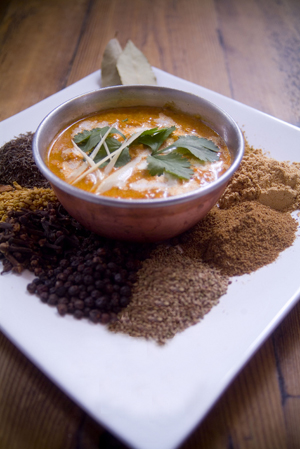
A bowl of curry nestled in classic Indian spices: cloves, pepper, curry, fennel, garam masala, ginger powder and yellow lentils, which are staples in Northern Indian cuisine. Photo by Christopher Bishop | Dreamstime. |
| WHAT IT IS: High-quality, heat-and-serve Indian main and/or side dishes. |
| WHY IT’S DIFFERENT: Very high quality for a very low price. Seven vegetarian varieties. The line extends beyond the shelf-stable foods in this review, to chutneys, curry pastes and frozen meals. |
| WHY WE LOVE IT: It’s like having an Indian restaurant in the pantry—but so much less expensive and more convenient. Whenever we want Indian food, we can have it in 5 to 10 minutes. |
| WHERE TO BUY IT: KitchensOfIndia.com. |
|
|
 |

Kitchens Of India:
A Feast In Your Kitchen
CAPSULE REPORT: Do you like Indian food but don’t have enough opportunities to enjoy it? Are you not very familiar with Indian food, perhaps because there isn’t much of it where you live? Kitchens of India is about to change all that, and make an excellent Indian meal as commonplace in your home as a good pasta dinner. And you don’t even need to boil water, since it’s all microwaveable.
We love Indian food, and live in a town where there’s plenty of it; so we are particularly fussy about what we eat. Now, instead of trying to schedule a trip to midtown, we head to our kitchen, grab a bag or three of Kitchens of India ready-to-eat dishes and microwave a feast (the bags can be boiled, or the contents heated in a pan, as well). Meat, poultry or seafood can be added to augment these vegetarian dishes. But the recipes are so complex and savory, few will notice the absence of meat. Why not plan an Indian buffet in your home? Find an inexpensive tablecloth in jewel colors, get a good CD or two for background music and rent a Bollywood blockbuster, for a new spin on “dinner and a movie.” At $2.99 apiece, Kitchens of India won’t break the bank. The line is certified kosher; most are vegan/pareve. Read more and see the photos in the full review below.
|
| |
|
|
THE NIBBLE does not sell the foods we review
or receive fees from manufacturers for recommending them.
Our recommendations are based purely on our opinion, after tasting thousands of products each year, that they represent the best in their respective categories. |
Easy Indian Cooking
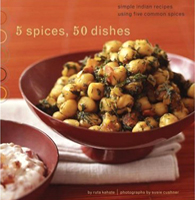 |
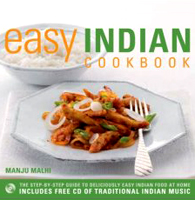 |
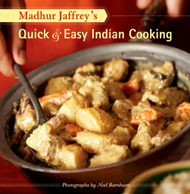 |
5 Spices, 50 Dishes: Simple Indian Recipes Using Five Common Spices, by Ruta Kahate. Make your introduction to Indian cooking simple, by mastering 50 dishes that require only five easily-available spices. Click here for more information or to purchase. |
Easy Indian Cookbook: The Step-by-Step Guide to Deliciously Easy Indian Food at Home, by Manju Malhi. The book includes a CD of Indian music, to cook to and serve with. This should be a standard with cookbooks, going forward! Click here for more information or to purchase. |
Quick & Easy Indian Cookery, by Madhur Jaffrey. Jaffrey is the grand dame of Indian cookbooks. Many of her works are out-of-print, but grab them whenever you see them. Here, she makes difficult dishes seem easy. Click here for more information or to purchase. |
Kitchens Of India: A Feast In Your Kitchen
INDEX OF REVIEW
|
MORE TO DISCOVER
|
Introduction
You generally don’t find food this good produced by huge companies. Kitchens of India is a brand of ITC Limited, one of India’s largest companies, with chains of hotels, restaurants, retail stores, consumer goods and agribusiness. Think of it as a mini Altria Group of India, a multinational corporation that makes everything from cigarettes to India’s version of Kraft Foods, producing leading consumer food brands. ITC hotels, one of the leading luxury hotel chains in India, is well-known for its gourmet restaurants Bukhara, Dakshin, Dum Pukht and Gharana, named after regional cuisines of India. Visiting dignitaries, heads of state (including William Jefferson Clinton) and royalty have dined on their authentic regional cuisine. And now, the same master chefs who create the cuisine for ITC have created the Kitchens of India line of shelf-stable,* heat-and-eat specialties, using the same recipes and cooking techniques. *No refrigeration required.
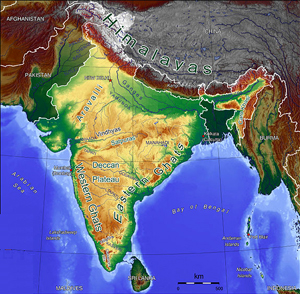
The Indian subcontinent is a large peninsula, south of the Himalaya Mountains that includes the republic of India as well as the nations of Bangladesh (the dark green area wedged in between the lighter green, yellow and red areas of India that are west of Burma on the map, Bhutan and Nepal at the very north, and Pakistan at the west. The large island off the right (eastern) of tip of the subcontinent is Sri Lanka, previously known as Ceylon. Afghanistan is to the west, China to the north, and Myanmar (Burma) to the east. Map courtesy of Wikipedia.org.
|
And, the food is really good. With seven choices (and hopefully, more to come), you no longer have to find an Indian restaurant. Just find Kitchens of India—you can order it online, and there is national retail distribution—and the food festival starts in your kitchen. Maharajahs ate these dishes, so your own princely palate will be well served.
Introduction To Indian Cuisine
First an introduction to Indian cuisine. It’s a huge country—so huge that it’s been called a “subcontinent.” The area comprises 1,269,346 square miles and a population estimated at 1.12 billion in 2007 (the U.S. is about three times larger, at 3,794,066 square miles and one-third the population, an estimated 303,580,000 in 2008).
A Word About Curry
When most Americans think of Indian food, the first thing that pops to mind is curry. But thinking of Indian food as “curry” is like thinking of American food as steak with a baked potato. It’s just one dish out of many that are enjoyed nationwide, and some variations are never seen outside their region (a chicken-fried steak doesn’t appear outside of the Southern United States, except at Southern-style restaurants).
|
The dish appears to have originated in East India; although the the word “curry” (kari) itself dates back to 1590–1600 in the Tamil language of Southern India, where it originally meant a spiced sauce or relish for rice. Today, curry dishes are made all over the country, pungent dishes of meat, seafood or vegetables flavored with curry powder, and usually eaten with rice. There is no spice or herb called “curry”; curry powder is a blend of numerous spices. Typical with spice blends, the particular ingredients and proportions vary by region and by household (and by nation—Thai curries are very different, for example), and generally include a base of coriander seed, cumin and turmeric, plus any combination of cayenne, chiles, cloves, fenugreek, ginger, mustard seed, pepper and other spices. Think of an American cook making a stew: The variation of seasonings possible is vast. It’s the same with Indian cooks making up a curry powder—but more so.
India’s Regional Cuisines
As with most countries, the styles of cuisine fall along geographic lines. Here’s how to make sense of the cuisines of India based on the regions and the states within them:
- North Indian Cuisine
Benarasi, Bhojpuri, Bihari, Kashmiri, Mughlai, Pahadi, Punjabi, Rajasthani, Uttar Pradeshi
- South Indian Cuisine
Andhra, Hyderabadi-Manglorean, Karnataka, Kerala, Tamil
- North-East Indian Cuisine
Assamese, Naga, Sikkimese, Tripuri
- East Indian Cuisine
Bengali, Oriya
- West Indian Cuisine
Goan, Gujarati, Maharashtrian/Marathi, Malvani/Konkani, Parsi
As with the United States, the vast longitude of the Indian subcontinent provides every type of climate zone and growing region from subtropical to Alpine. The ingredients, both vegetable and animal, that are available in the different regions vary substantially. In the south of India, the fresh produce and herbs available year-round is similar to the lush offerings of Southern California or the sunny Mediterranean. In the north, while the produce is more seasonal, year-round dairying produces the delicious cheeses and milk products people find in Northern California and Switzerland. Dishes and spices served in the north are not seen in the south, and vice versa. And while it’s easy to think of Indian food as “curry,” this geography, along with invasions throughout the millennia (Aryans, Muslims and Mongols, each of whom brought their cuisines), have produced an extremely varied and rich culinary tapestry.
The Cuisine Of Northern India
Cattle and yaks are plentiful in the Alpine-like climate of the north. Northern Indian dishes thus incorporate a proportionally high amount of dairy products—milk plus ghee (clarified butter), paneer (a fresh, cooked-curd cheese in the same group as cottage cheese, farmer’s cheese and ricotta) and yogurt. The kebabs and most of the meat dishes served in Northern India arrived via the Muslim invasion (during the 5th to 7th centuries, C.E.). Pakistan was part of North India prior to the partition of India, so Pakistani cuisine is almost identical.
Common seasonings include hot chiles and saffron. Garam masala (see photo at right), a blend of ground spices common in Northern Indian, Pakistani and Bengali cuisine, is often added to dishes at the end, to preserve its complex and highly-fragrant aroma. As with curry powder (or any blended ingredient from any country—Morocco’s ras el hanout is another good example), there are many variations of the garam masala blend. Most use cinnamon, roasted cumin, caraway seeds, cloves, nutmeg (and/or mace) and green cardamom seeds or black cardamom pods.†
†Commercial mixtures of garam masala often include less expensive spices such as bay leaf, coriander, chile, fennel seed, garlic, ginger powder, mustard seed, sesame seed, turmeric and star anise. Purchasing pre-ground garam masala is not recommended in general, as ground spices quickly lose their aroma and potency and the objective is to capture the wonderful fragrance. It is better to buy an unground mix (or gather and mix your own components), and grind the spices as needed in a mortar and pestle or spice grinder (you can use a coffee bean grinder dedicated to spices).
|
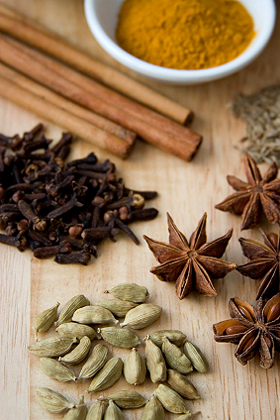
Garam masala, a blend of ground spices common in Northern Indian cuisine, is often added to dishes at the end, to preserve the aroma of the spices. Shown from top: turmeric, fennel seed, star anise, cardamom, cloves and cinnamon sticks. Photo by Georgina Palmer | IST. |
- Tandoori cooking, which produces India’s version of barbecue chicken, comes from the Punjabi region. The chicken is marinated in a yogurt seasoned with garam masala and other spices. Cayenne or other red chile powder is applied to the flesh to give it a red color (or turmeric is used to make it orange—these days, food colorings also are used). The dish dates to the Mughal Empire (the 15th to mid-19th centuries), begun when, in the early 16th century, Muslim armies from Afghanistan, Mongolia, Persia and Turkey invaded India.
- A griddle called the tawa is used to bake roti and paratha flatbreads. Poori and bhatoora breads are deep fried in oil. The large, cylindrical, coal-fired tandoor oven is used to bake breads such as naan and kulchi, and tandoori meats.
- The samosa, a filled fried pastry, is a favorite snack (it has spread to other regions). Like a knish, it can be filled with cheese, meat, potatoes and other vegetables (mushrooms, chickpeas).
- Lentil and other vegetable-based dishes are pervasive.
- Roghan josh, lamb dish in a spicy red sauce, comes from Kashmir (the sauce contains many ingredients; the red color comes from chili powder).
- Dom Pukht is a royal cuisine that dates back to the era of the Nawabs of Awadh, rulers of the Northern Provinces of India during the 18th century. It is characterized by a unique style of steam cooking. The dishes are cooked in traditional degs or handis, which are sealed with atta or kneaded flour, to trap the steam. The vessels are then placed over glowing coal fires so the food can simmer in their own juices, until tender. The resulting rich flavors were enjoyed by maharajas.**
**Maharajah was a title meaning “high king,” which ranked above lesser kings (rajahs) or princes of an Indian sovereign state. The title of maharajah was based on the wealth and power of his state. Before achieving independence from Great Britain in 1947, India (which then included present-day Pakistan) consisted of more than 600 princely states, each with its own ruler. In a Hindu state, the title was often Raja or Thakur, in a Muslim state, Nawab.
The Cuisine Of Southern India
Daskin cuisine, the cuisine of Southern India, highlights the traditional flavors of the four south Indian states of Andhra Pradesh, Karnataka, Kerala and Tamil Nadu (side note: the capital of Karnataka is Bangalore, which became prominent as the “Silicon Valley of India”). The Southern Indian peninsula might be called the “France” of India, where cooking transcends into an art form. Dishes are more elaborate; the cook must consider the most minute details, as opposed to the simpler dishes of East and West India.
Hot climates in general are known for hot and spicy seasonings, and Southern India is no exception. Here, hot chiles ratchet up the spice level. The cuisine emphasizes rice, the staple food that is grown there (it is basmati, an aromatic, long-grain, slender rice—see the photo below and our Rice Glossary for more information). The region is known for extravagant rice dishes, accompanied by dal (lentil dishes). In South India, the dals and curries tend to be a soupier style, and local coconut and banana trees mean that coconut milk and coconut oil are used in recipes, and banana leaves are used for presentation. Except for the coast, where seafood is prevalent, the area is largely vegetarian.
Most meals include a biryani (rice dish), dal, other grains and vegetable dishes accompanied by chutneys, pickles and papaddams (crisp flatbread). There is often a sambar (a pea and vegetable stew) and rasam, a soup that takes many forms (it can be based on tomato, tamarind, lime, etc.). Each state has its own, very distinctive way of preparing sambar—just as each of the southern states in the U.S. has its own way of preparing barbecue, and you know just by looking at it what state’s style it is.
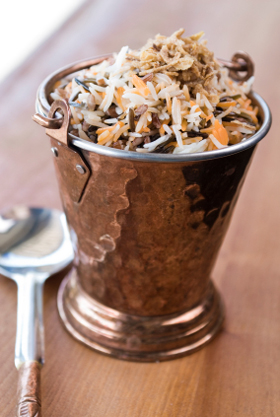
While historically, short-grain rice was grown in the south of India, today the whole country uses long-grain basmati rice. Shown above, white and brown basmati, mixed with shredded carrot and garnished with toasted coconut. While Indian food is served in beautiful burnished copper dishes, if you have silver julep cups, use them so serve portions of rice.
|
- In sharp contrast to Northern Indian cuisine, there is limited use of garam masala and other dried spices (except for black pepper, cardamom, dried red chiles and turmeric). That’s not surprising because in southern climates, fresh herbs are available year-round, along with garlic and ginger. The cooks take advantage of fresh green chiles and produce like plantains and tamarind.
- Biryani (also spelled biriyani), a rice dish ubiquitous on Indian restaurant menus in the U.S., originated in Southern India. It generally is made with a choice of chicken, lamb, prawns or vegetables.
- Meat curries, prawn dishes and pathiris are also regional fare.
- The dosa, a crêpe made from a batter of rice and black lentils (also called black gram or urad beans), is a popular breakfast food and snack. It can be filled with meat or vegetables and sauced. It is served as an appetizer at Indian restaurants in the U.S.
†A biryani is different from a pilaf. A pilaf is boiled in a meat broth. Biryani is Farsi (Persian) for “fried before cooking,” and the dish is presumed to have come to India via Arab traders or Muslim invaders. After the rice is stir-fried in ghee, which gives it a nutty flavor, it is boiled.
|
The Cuisine Of Eastern India
East India has undergone long periods of European colonization: Both the British East India Company and the Dutch East India Company were established there in the 17th century, to trade in spices and other products.
Eastern Indian cuisine is rich in seafood drawn from coastal waters, and is prepared in many ways. Fish curries and fried seafood are dishes that are most familiar at restaurants in the West. Rice is the staple grain. It grows in the region, abetted by a moist, rainy climate.
In general, the cuisine is a lighter style in both the amount of spice and the preparation.
Spices are used with a lighter hand and cooking methods include steaming and stir frying.
There’s a sweet tooth gene in East India. The region is famous for its broad spectrum of desserts—also on the lighter side. Milk-based sweets are a specialty in Bengal and Orissa, including puddings like the ones at the right.
If you look at the map of India, you’ll see that Bangladesh is adjacent to East India. As a result, the Bangladeshi cuisine is very similar.
|
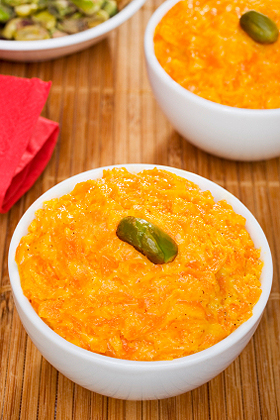
Puddings, called halwa (pronounced halva) are a popular sweet (shown here, decorated with pistachio nuts). They’re made with vegetables—carrot, sweet potato and pumpkin, for example, plus sugar and condensed milk—and are very rich. Photo by Linda & Colin McKie | IST. |
The Cuisine Of Western India
There are four major states in Western India, each with individual food styles. The Rajasthani, Maharashtrian and Goan cuisines are based on white rice, while Gujarati dishes use a wheat base. Roti and other flatbreads are served with most meals in Gujarat. Cuisine is predominantly simple vegetarian, reflecting the values of Jainism, an ascetic branch of Hinduism. The Goan cuisine has influences from its Portuguese colonial era, and many seafood dishes and coconut accents. Maharashtrian cuisine has similar foods in its coastal area, but in its hill and plateau areas, coconut is traded for peanuts (known in India, the U.K. and other former British protectorates as groundnuts, since the vines grow along the ground), along with meat instead of fish, plus some wheat.
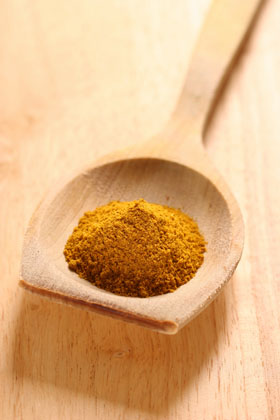
|
The cuisine is healthier than other regional cuisines, starting with a lower use of of fat. Small amounts of peanut oil are used instead of large amounts of ghee, and a lack of visible oil is a desirable quality in a dish. Vegetables are often steamed, deep-frying is rarely used. Sweet and sour is a prominent seasoning, created with jaggery, a type of deep brown sugar, and tamarind (see our Sugar Glossary for more information). The regional kala masala employs some of the same spices of garam masala (cardamom, cinnamon, clove, peppercorn, turmeric) along with local coconut, coriander, cumin, sesame, poppy and local herbs and spices. To give you some geographical grounding, Jaipur is the capital of Rajasthan and Mumbai (Bombay) is the capital of Maharashtra and the largest city in India, with a 2007 population of more than 13 million.
Indian cuisine, like most others, divides itself into main dishes, condiments, sweets/desserts, snacks, beverages, and the spices that flavor them all. Kitchens of India makes foods in all of these categories, and all are good. In this review, we’ll focus on the main dishes and a few desserts. |
The golden color of curry powder is due to the bright golden color of turmeric, a key ingredient. Turmeric (shown above) is a tropical plant (Curcuma domestica) cultivated in India. It is a rhizome (a plant with a horizontal, often underground, stem that often has value, like ginger root), broadly cultivated in India. The plant has yellow flowers and an aromatic, fleshy rhizome that is ground into the powder shown above, which is used as a spice and a yellow dye. Photo © Maja Schon | Dreamstime.
Kitchens Of India
Kitchens of India’s vegetable- and bean/lentil-based dishes, made by ITC’s master chefs and imported from India, are packaged in 10-ounce foil pouches, which in turn are in packaged slender boxes. The pouches can be boiled on the stove top, emptied into a pan and heated, or easily microwaved. Each package contains 2.5 half-cup servings, although three varieties plus rice made an ample lunch for four of us. Indeed, the dishes are so delicious that an Indian buffet with all varieties is in order (see Serving Suggestions, below).
The products are all natural, and half are made with vegan/pareve sunflower oil instead of ghee, a dairy-product. Dishes are noted as vegan/pareve and non-vegan/not pareve.
Basmati Rice Pilaf With Vegetables (Hyderabadi Vegetable Biryani)
This biryani is from Hyderabad, the capital city of the Indian state of Andhra Pradesh in Southern India (and in 2007, the sixth largest city in India). It was enjoyed by the Nizams, the royal rulers from 1719 until India’s independence in 1947 (in 1937 the last Nizam was named the wealthiest man in the world by Time magazine). For common folk, it’s easy to whip up a pilaf (or make white or brown basmati rice) to go with the Kitchens Of India vegetable dishes. But for a good rice dish, microwave ready in 2 to 3 minutes, this biryani and its companion below can’t be beat! As we explained earlier, it’s not really a pilaf, where the rice is cooked in a meat broth (either this technicality got lost in translation, or the Kitchens of India folks didn’t realize that THE NIBBLE editors would know the difference). In this vegetarian dish, the rice is flavored and colored with saffron and ginger and dotted with carrots, green beans, onions and potatoes. You can add even more spark by dressing the dish with some fresh parsley before serving, but it’s flavorful enough without it. This dish is not vegan/not pareve, as yogurt is added to the recipe.
Basmati Rice Pilaf With Vegetables & Nuts (Kashmiri Vegetable Biryani)
Head up to the northwest corner of India, and you come to the state of Kashmir, where the goats‡ whose hair makes the finest wool garments in the world, gambol. The locals enjoy almonds, cashews and raisins in their biryani. The dish is also made with carrots and peas, and uses cream instead of yogurt. We enjoyed both biryanis, with a slight preference to this one because the nuts and raisins are so enjoyable. It is not vegan/not pareve.
‡The goats, of the species Capra hircus laniger, reside in various nations in the high plateaus of Asia. China is now the largest producer of raw cashmere, followed by Mongolia. India, Pakistan, Iran, Afghanistan, Turkey and other Central Asian Republics still produce significant, albeit lesser, amounts.
Black Gram Lentils Curry (Dal Bukhara)
Gram is a word given to chickpeas and other beans, such as the urad bean, also known as the black lentil. The translation, “black gram lentils,” on the Kitchens of India box is thus a bit redundant, and the word “gram” will likely confuse American audiences (but not you, now that you know what it means). Dal Bukhara (lentils, Bukhara style) is a dish of whole black lentils in a thick tomato gravy, with a skillful balancing of spices, simmered over a slow coal fire for hours. According to the Kitchens of India master chefs, Dal Bukhara is the only dal (lentil dish) that doesn’t fall into pieces, despite 18 hours of stirring. The nutty flavor of the lentils is the main attraction here, giving the buttery (cream and butter-based) dish an earthy richness, while bottom notes of ginger and coriander add dimension. Not vegan/not pareve.
A historical note: Bukhara, for a long time part of the Persian Empire (now a city in the republic of Uzbekistan), sits at the northwest frontier of India. It was a stop on the Silk Road, a meeting place for traders from Asia and Europe, as well as a religious, cultural and educational center. Eat this dish, and think of its place in history.
|
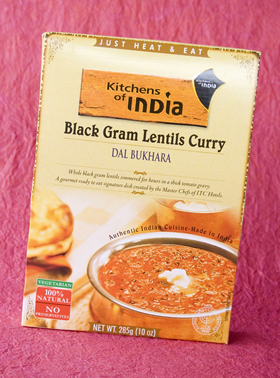
Black lentils are indeed black (with white “eyes”), but are swimming in a red sea of tomato purée and chile powder. Photo by Claire Freierman. |
Chick Peas Curry (Pindi Chana)
We’re guessing the interesting—and tasty— tartness of this dish comes from the pomegranate seed powder and tea leaf extract in the recipe. The green chillies (we use the British spelling, as Kitchens of India does) added a degree of heat we didn’t taste in the other dishes. The chick peas, potatoes, onions and tomatoes have a great texture, with a slightly thicker consistency than the other dishes. It should be served with rice and a flatbread like naan (read our review of Fabulous Flats Tandoori Naan). The dish is named after its city of origin, Rawalpindi, in the state of Punjab in Northern India. Vegan/pareve.
Mashed Vegetable Curry (Pav Bhaji)
With a texture comparable to that of a thick tomato chowder, chunky vegetables are simmered in butter. A great way to get the kids to eat their veggies, if the kids like ginger, garlic and other spices. The vegetables include bell peppers, onions, peas, potatoes and tomatoes. The dish hails from Mumbai (Bombay) in West India. Not vegan/not pareve.
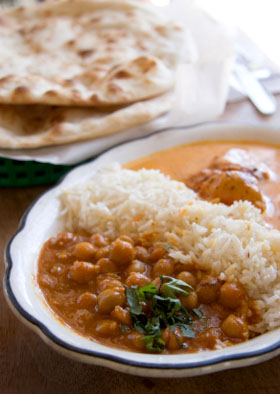
Chick Peas Curry, or Pindi Chana, combines chick peas and potatoes in a sauce of tomatoes and onion, with
rich spices (“curry” refers to the spice mixture). Here,
it is served with steamed basmati rice, and Lamb Vindaloo. Naan, a flatbread baked in a tandoori oven,
is at the rear. Learn more about naan in our review of Fabulous Flats Tandoori Naan. Photo by Kristen
Johansen | IST.
|
Mild Chilli Curry (Mirch Ka Salan)
Yes, you can love eating whole chilies. These chillies are mild, succulent and simmered in a thick but delicate-flavored, buttery curry sauce made of roasted peanuts, almonds and sesame seeds, with accents of coconut, tamarind and coriander. The chillies look beautiful, too: a nice complement to a meat dish. Mirch Ka Salan is a famous recipe from Hyderabad, the capital city of the state of Andhra in Southern India. It is prepared the ancient Dum Pukht style of cooking, steamed in sealed vessels. Serve it with basmati rice and Indian bread. Not vegan/not pareve.
Mixed Vegetable Curry with Cottage Cheese (Navratan Korma)
We were most impressed by the texture of this tomato- and cream-based sauce, with a mild cashew flavor. While cashews are typical of Eastern Indian cuisine, this is a Mughlai dish from the Mughal Empire of Northern India (the cream-based sauce is a strong hint of its northern origins). It contains nine different vegetables (navratan means “nine gems”) that, despite being cooked, shelf-stabilized and then re-heated, were as firm as if fresh-cooked. We also really enjoyed the dish’s mild heat and clove-scented sweetness. Serve this dish with steamed basmati rice and/or Indian bread. Not vegan/pareve.
|
Red Kidney Beans Curry (Rajma Masala)
Yet another favorite, this spicy, tangy dish has delicate aromas of citrus and cumin, though only garlic, ginger and “spices” are listed on the label. The protein-packed kidney beans are filling, and tomatoes and onions add to the hearty texture. This is a Punjabi dish from Northern India. Serve it with steamed basmati rice and/or Indian bread. Vegan/pareve.
Spinach with Cottage Cheese and Sauce (Palak Paneer)
Another of our favorites of the bunch, the English translation does not do this dish any favors. Let us assure you, it has nothing to do with a bed of spinach topped with cottage cheese. The “cottage cheese,” paneer, takes a tofu-like shape and comes off more as queso fresco than American cottage cheese. Those who don’t like to eat their spinach might easily be tricked into eating this delicious spinach purée. We love the grassy freshness of the spinach, and the bright green color looks beautiful on the plate. All too often, chefs who are heavy-handed with fats ruin dishes like this one. Although we wouldn’t call Kitchens of India’s preparation low fat, the cream and butter weren’t overwhelming, allowing the spinach to shine through. Palak Paneer originated in Northern India (the cheese is a giveaway). Not vegan/not pareve.
|
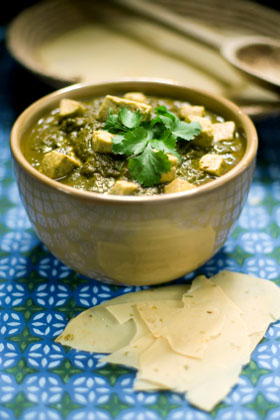
The spinach and “cottage cheese” dish known as Palak Paneer is a crowd pleaser. Photo by Christine Glade | IST. |
Ready for dessert?
Try two tasty puddings (photo above). While good alone, you can dress them up with any combination of golden raisins or other dried fruit, slivered almonds or whole or chopped pistachios, and whipped cream or crème fraîche. You can also serve the warm puddings with vanilla ice cream, in the manner of Indian Pudding.
Yellow Lentil & Milk Pudding (Moong Dal Halwa)
A delicacy of North Western India, yellow lentils are simmered in evaporated milk and saffron, plus almonds. Not vegan/not pareve.
White Pumpkin & Milk Pudding (Petha Halwa)
From the North Central Indian state of Uttar Pradesh, this recipe was perfected in the royal kitchens of Agra, the home of the Taj Majal—although perhaps before the Taj kitchens were completed in 1648. This is a confection of grated white pumpkin, sugar, milk and evaporated milk. We give this a slight edge over the Yellow Lentil Pudding. Not vegan/not pareve.
Serving Suggestions
Serve your Kitchens of India main dishes with:
- Basmati rice—plain, laced with saffron and/or carrots and peas
- Warmed flatbread (naan, roti or the more readily-available pita, which approximates the texture and shape of Indian-style flatbreads—or pappadams, if you can find them)
- Chutney, for some extra sweetness and spice
- Raita, to cool down the heat of the chillie-infused recipes (here’s a raita recipe—you also can use plain yogurt [we recommend Greek-style yogurt like FAGE Total] or fromage blanc)
- Beer, assam tea (no milk or sugar) or iced tea are the beverages of choice
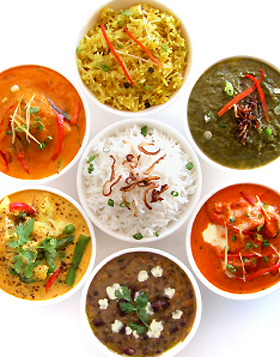
Have a family feast or a party for friends. Photo by Isatori | IST. |
These carefully-spiced, hearty vegetarian dishes can stand alone, but are also a great accompaniment to grilled or roasted meat, chicken or seafood. You can use Devya’s Indian Gourmet Simmer Sauces to make butter chicken or tandoori chicken to go with your Kitchens of India vegetarian dishes.
So...whether you’re ready to party (as we suggested in the capsule report at the top of this article), or just want to feed your family a variation on your regular American-Continental repertoire that can be on the table in three minutes: Start here!
You might also use these varied dishes as a geography lesson, to understand the different regions of India. You can purchase a large map of the subcontinent and cut out the food photos on the front of the Kitchens of India boxes, pinning them to the regions where they originated. It sure does put things in perspective. Think of Indian families doing the same thing with American foods, pinning on a map of the U.S. an avocado and sprouts sandwich, a bagel and lox, clam chowder, a deep dish pizza, fried chicken, etc. and learning for the first time exactly where Boston, Chicago and Savannah are.
|
Indian cuisine won’t be considered comfort food by most American households. But we take great comfort, now that we can have almost instant Indian dinners of high quality, whenever we wish.
— Karen Hochman
FORWARD THIS NIBBLE to anyone who loves Indian food, to people who have been wanting to try it, and to those who are looking for easy party ideas.
KITCHENS OF INDIA
Ready-To-Eat Fine Indian Foods:
Basmati Rice Pilaf With Vegetables and With Vegetables & Nuts, Black Gram Lentils Curry, Chick Peas Curry, Mashed Vegetable Curry, Mild Chilli Curry, Mixed Vegetable Curry with Cottage Cheese, Red Kidney Beans Curry, Spinach with Cottage Cheese and Sauce, Yellow Lentil & Milk Pudding, White Pumpkin & Milk Pudding
Certified kosher by Kosher Inspection Service
- 10-Ounce Packages (Vegetable Dishes)
8.8-Ounce Packages (Rice & Puddings)
Box Of 6 Packages
$2.99 Each
One Package Serves 2-3 People
As Part Of A Multi-Item Dinner
(Two Items Plus Rice, e.g.)
Purchase online* at
KitchensOfIndia.com
Also available at Amazon.com and at retailers nationwide.
*Prices and product availability are verified at publication but are subject to change. THE NIBBLE does not sell products; these items are offered by a third party with whom we have no relationship. This link to purchase is provided as a reader convenience. |
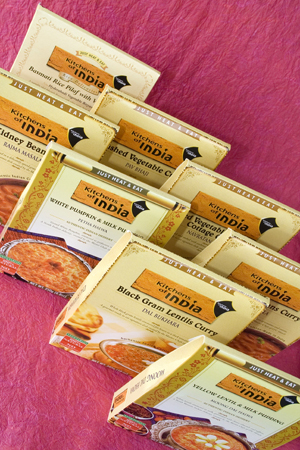
Get ready for an Indian buffet! Photo by Claire Freierman.
|
Read About These Favorite
Products:

|
Check Out These Other “Top Pick Of The Week” International Foods:
|
FOR ADDITIONAL INFORMATION, special offers,
contests, opinion surveys, THE NIBBLE
back issues archive, product gift-finder and more,
visit the home page of TheNibble.com.
Do you have friends who would enjoy THE NIBBLE?
Click here to send them an invitation to sign up for their own copy. |
© Copyright 2004-2025 Lifestyle Direct, Inc. All rights
reserved. All information contained herein is subject to change at any time
without notice. All details must be directly confirmed with manufacturers, service
establishments and other third parties. The material in this e-zine may not
be reproduced, distributed, transmitted, cached, or otherwise used, except with
the prior written permission of Lifestyle Direct, Inc.
|
 |




|
 |























